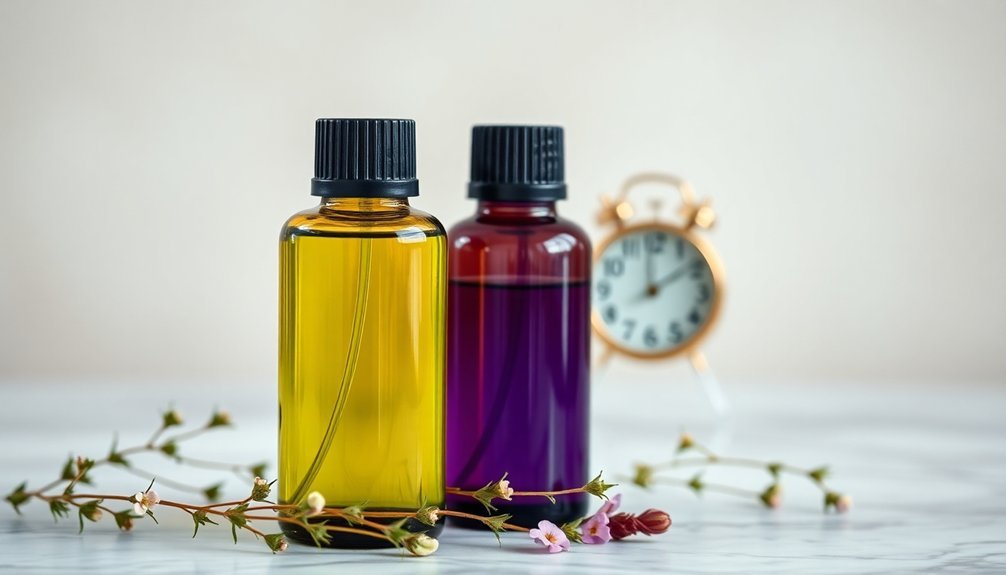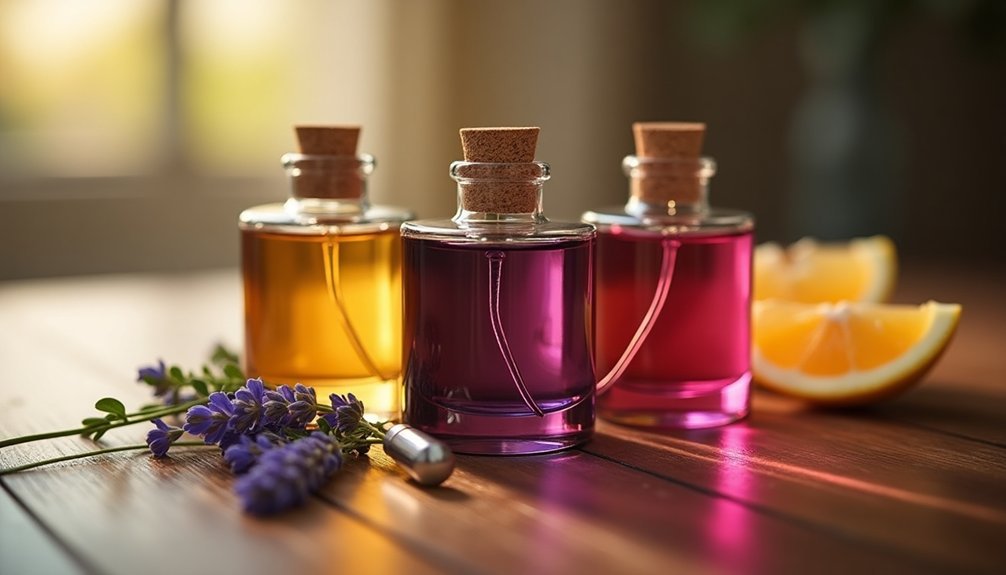Start your oil layering journey with rich base notes on moisturized skin to create a lasting foundation. You'll want to apply oils strategically to pulse points like wrists, neck, and behind ears for maximum diffusion throughout the day. Don't rush between layers – follow the three-minute rule to let each scent settle properly before adding the next. These professional techniques will transform your essential oil blending into an art form.
Start With The Base Notes For A Long-Lasting Foundation

Three key aspects make base notes the essential foundation of any layered fragrance: their long-lasting nature, deep molecular structure, and superior skin adherence.
These heavier molecules create a solid platform that can persist for hours or even days on your skin. The dry-down phase eventually reveals the true character of your layered oils.
To maximize the impact of your base notes, start by applying them to moisturized skin. Choose from classic base ingredients like woods, musks, amber, or resins.
You'll want to dab, not rub, these oils directly onto your bare skin, as this preserves the integrity of the fragrance molecules. If you have dry skin, you might need extra moisturizing to help the scent last longer.
When you begin with base notes, you're setting up your fragrance for success, allowing lighter scents to layer beautifully on top throughout the day.
Master The Art Of Strategic Pulse Point Application
Strategic pulse point application elevates your fragrance experience by utilizing your body's natural heat zones. Focus on four key areas: your temples, behind your ears, neck, and inner wrists, where arteries run close to the skin's surface.
Start with clean hands and apply your diluted oils to slightly damp, moisturized skin after showering. You'll want to target the inner wrists and behind the ears first, as these spots provide ideal warmth for diffusing fragrances. Sweet almond oil makes an excellent carrier oil for diluting your essential oils before application.
For therapeutic benefits, concentrate on your temples and neck area. If you're using cooling oils like peppermint or eucalyptus, the inner elbows and back of knees work well.
Remember to use a light touch – a small amount goes a long way. Keep a travel-sized bottle handy for touch-ups throughout the day.
Perfect Your Layering Technique With The Three-Minute Rule

Building on your pulse point expertise, mastering the three-minute rule will take your fragrance layering to new heights.
Wait three full minutes between applying each layer of fragrance to guarantee proper drying and settling time on your skin. This essential waiting period prevents unwanted mixing of oils and allows you to accurately assess how the scents interact. Applying oils to well-hydrated skin will significantly improve their staying power.
Start with your heaviest base note, letting it fully absorb before adding lighter fragrances. You'll notice how each layer maintains its distinct character while contributing to a harmonious blend.
During these three-minute intervals, test the developing scent on a blotter to evaluate its evolution. If you're experimenting with new combinations, document your process and adjust the ratios until you achieve your desired result.
Frequently Asked Questions
Can I Layer Essential Oils With Commercial Perfumes?
Yes, you can layer essential oils with commercial perfumes. You'll want to apply your perfume first, then add complementary essential oils sparingly. Just test small amounts first to make certain the scents work well together.
How Do I Remove Layered Oils if I Don't Like the Combination?
You can remove layered oils by washing with gentle soap, applying baking soda paste, or using fragrance-removing wipes. If needed, dab a small amount of rubbing alcohol, but use it sparingly to avoid skin irritation.
Will Layering Oils Stain My Clothes?
Yes, layered oils can stain your clothes, especially darker oils like patchouli or citrus oils. You'll want to dilute them with carrier oils and avoid direct contact with fabric to prevent staining.
How Many Different Oils Can I Safely Layer at Once?
You should limit yourself to 2-3 oils maximum when layering to avoid skin irritation and scent confusion. If you've got sensitive skin, stick to just 2 layers and always patch test first.
Should I Layer the Same Oils Differently for Daytime Versus Nighttime Wear?
Yes, you'll want to layer differently for day and night. Use lighter, energizing oils during the day and save heavier, calming oils for nighttime. This supports your body's natural circadian rhythm.
In Summary
Now you're ready to create your own signature scent by layering oils like a pro. Remember to start with those rich base notes, strategically apply to your pulse points, and follow the three-minute rule between layers. Don't rush the process – let each oil settle into your skin. With practice and patience, you'll master the art of oil layering and develop a unique fragrance that's distinctly yours.





Leave a Reply